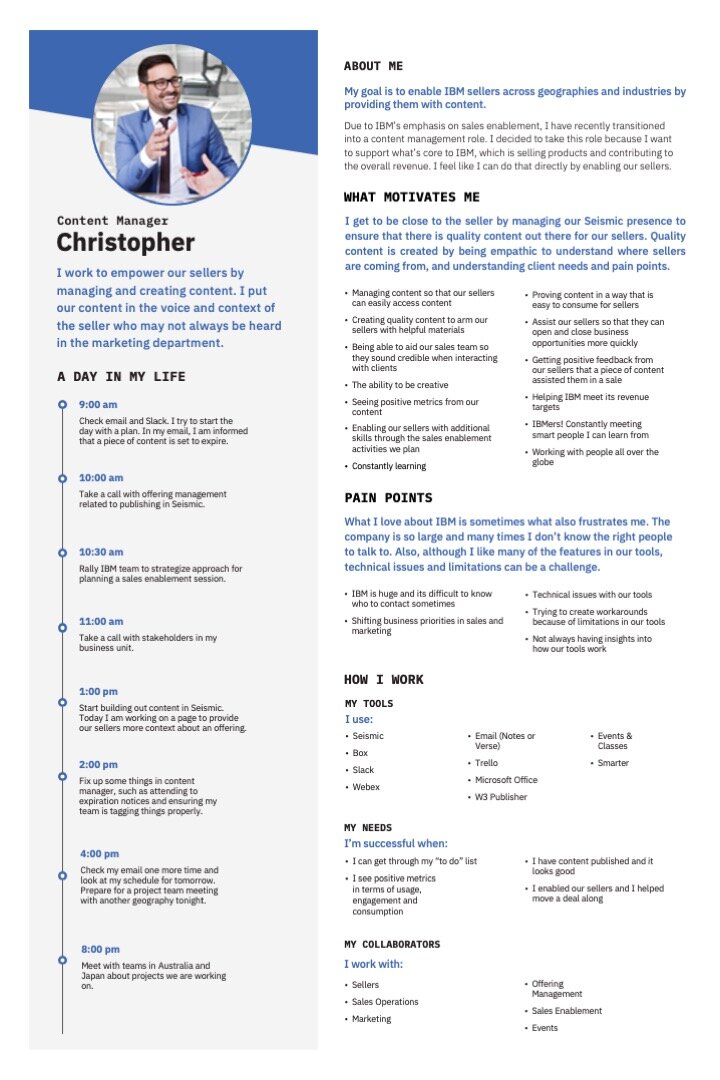Persona Development for Internal Marketing Organization
Context
During the summer of 2020, the IBM Marketing implemented Seismic, a sales enablement platform. The goal of Seismic was to support all IBM Sellers by saving time as a single destination for all things sales and providing an easy say to collaborate and personalize content.
The implementation of a new software across a huge organization like IBM does come with some downfalls:
Prior to my my joining, there was no research conducted before implementing this software onto the organization and thus there were many complaints around the tool. For example, people rated the performance and ease-of-use to be poor via surveys, but since no one had talked to any actual users, they weren’t aware what specific complaints they had with the tool.
Additionally, the tool was lacking a full understanding its users. So, we knew that our users were generally content managers and sellers, but we didn’t really have any insights about the users groups and their pain points
Therefore, the objective of this foundational project was twofold:
Add to the collective understanding of key users, their pain-points and provide opportunities for enabling a more effective set of tools
Evaluate the design of the tool for various user groups
The deliverables for the project were to:
Create personas around the roles of the IBM Content Manager and Sellers
Preform contextual inquires of the product from the perspective of the Content Manager and Seller
The following case study will focus on the first deliverable: Persona Creation
The second deliverable is outlined in the Ethnographic Evaluation of Internal CMS
Methods Used: Interviews
Tools: Mural
Timeframe: 6 weeks
Research Progression
Develop Protocol
Developed interview questions and a standardized testing procedure, with feedback from stakeholders.
Collect Data
Interviewed participants over the course of 2 weeks in 2-part sessions.
Analyze Data
The team used the method of affinity diagraming to identify themes in our user groups.
Deliverables
The result from testing was the development of 2 personas for the role of the IBM Content Manager and Seller.
Developing the Protocol
Questions were developed in order to gauge the characteristics and pain points of an IBM Content Manager and Seller.
Some examples of questions included:
What skills are required to do your job?
What are the most enjoyable aspects of your job?
What are the most difficult, challenging, frustrating or annoying parts of your job?
I recruited 6 IBM Content Managers and 8 Sellers to participate virtually in our interviews.
Analysis
To analyze the interviews data, I used open coding where I analyzed the data and found themes across participant responses and made affinity diagrams on Mural.
Each colored sticky represents a different participant’s answers.
I then made affinity diagrams and identified themes (black circles) across all my participants for each interview question that I asked.
Here is the full affinity diagram for all our with themes clustered for all the IBM Content Managers.
Results: Persona Creation
After all the qualitative data was clustered and diagramed. I then began to create personas for the roles of the IBM Content Manager and Seller.
In each persona, I identified what a typical day looks like for the roles, along with what motivates them to do their job, some of the tools they use, who they work with and some frustrations they have with their current role.


Results: Recommendations for Improving Workflow
Based on the pain-points that were identified in the personas, I also identified recommendations that would improve the workflow and streamline processes for the IBM Content Manager and Seller.
Content Managers
Provide IBM Content Managers with a list of references of people to talk to about a specific offering (e.g., product managers, technical sellers, SMEs)
Improve the user experience of Seismic, as IBM Content Managers and frequently in this tool and have a lot of technical difficulties with it
Sellers
Streamline processes so that IBM Sellers can provide clients with proposals more quickly (deep dive below)
Incorporate sales material on a smaller subset of tools to decrease information duplication
Provide IBM Sellers with high-level sales kits for all offerings and a list of technical resources and SMEs for a particular offering (deep dive below)
Recommendation for IBM Sellers: Streamline Organizational Processes
Problem: Sellers are frustrated with the amount of processes they must go through in order to submit proposals to a client.
“Every time we want to get something done, we have to go up the chain. It just takes away your ability to be nimble and be flexible with your clients.
”
Recommendation: Streamline organizational processes so that employees are empowered to do their jobs
E.g., automating the approval processes for for action items
E.g., providing less approvals for more experienced employees
Recommendation for IBM Sellers: Provide High-Level Information on Offerings in One Place
Problem: IBM Sellers oversee a large portfolio of products and need quick information to be able to progress a sale
“My role is not specific. IBM has got a zillion different product and solutions. Customer tells me something, how do I turn back around and find out IBM have a solution? How do I find out who would be the person that I talked?”
Recommendation: Provide high level description of all IBM products and services in one place for the IBM Seller.
Also, provide a list of technical resources/SMEs for specific offerings so that the Seller can access it quickly
Readout & Next Steps
The IBM Marketing Organization was able to use these personas to develop further tools that would aid internal employees. This project was able to create empathy and an understanding of internal IBM Marketing employees by showcasing their pain-points and provide opportunities for enabling a more effective set of tools.
In Part 2 of this larger project, I then conducted an Ethnographic Evaluation of Sellers and Content Managers using the Seismic tool.


